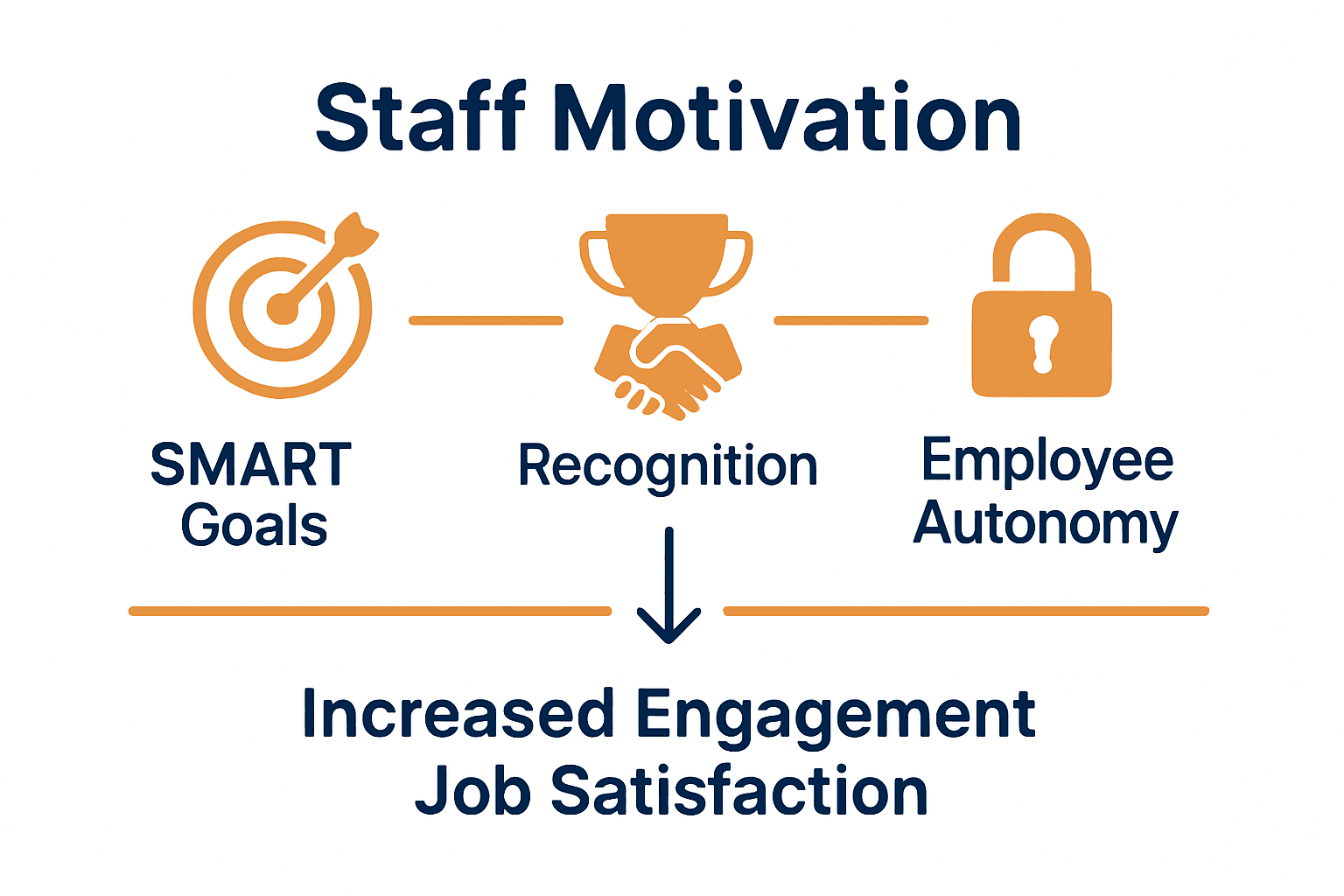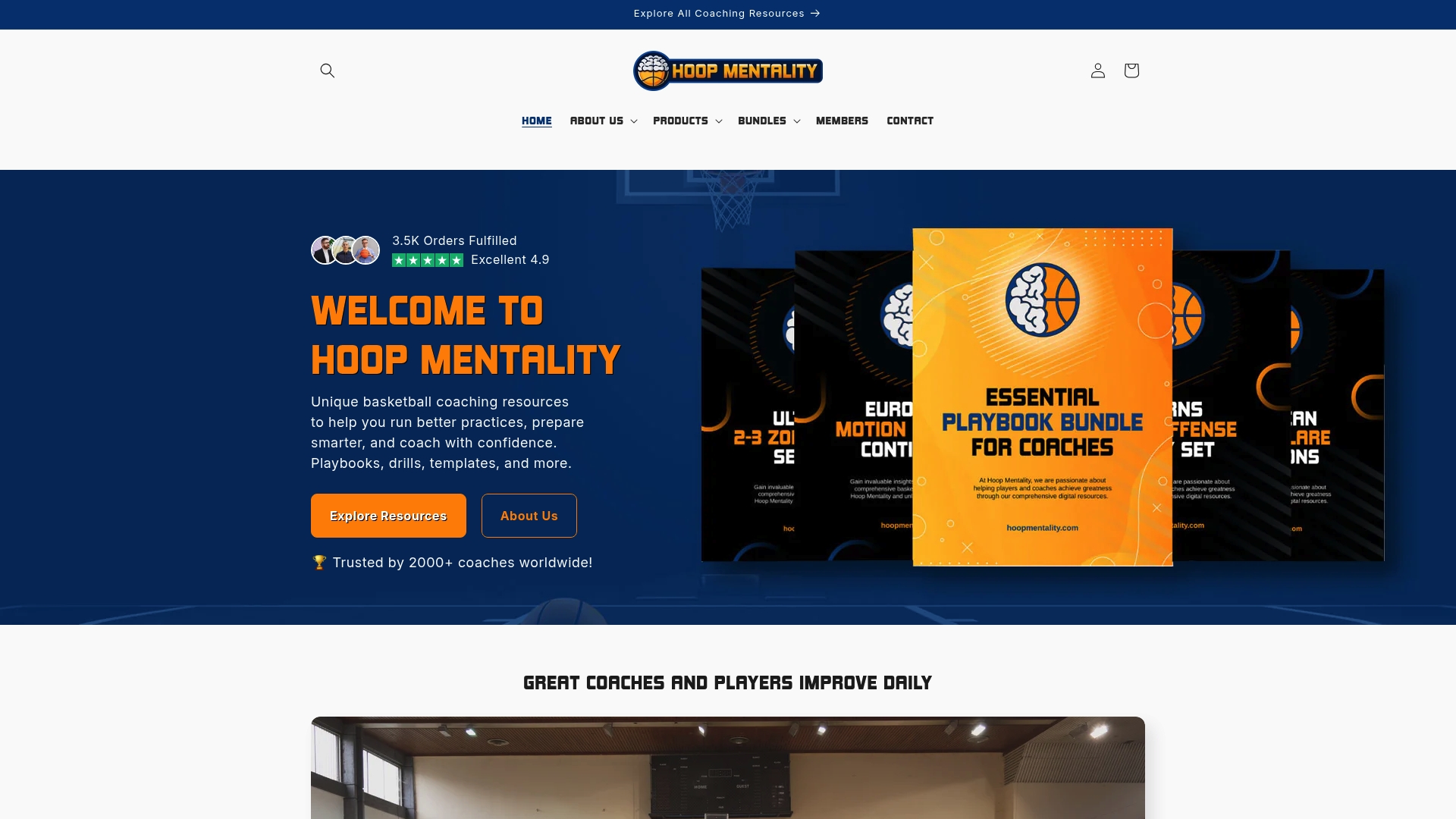Nearly 9 out of 10 employees say that personal recognition from leaders drives their motivation at work. Understanding what inspires teams goes far beyond salaries or job titles. In today’s fast-changing workplaces, finding the right motivation techniques can shape stronger performance and deeper engagement. This guide reveals proven strategies that help leaders energize teams, set meaningful goals, foster trust, and create lasting job satisfaction.
Table of Contents
- Defining Staff Motivation Techniques
- Goal‑Setting And Incentive Strategies
- Building Trust Through Autonomy
- Feedback, Recognition And Coaching
- Supporting Well‑Being And Balance
Key Takeaways
| Point | Details |
|---|---|
| Understanding Motivation | Staff motivation is a multifaceted process that includes psychological, social, and organizational dynamics influencing performance. Recognizing both intrinsic and extrinsic factors is essential for effective engagement strategies. |
| Goal-Setting Framework | Implementing SMART objectives helps to create clear, achievable goals that align individual efforts with organizational expectations, enhancing motivation and performance. |
| Building Trust Through Autonomy | Empowering employees through autonomy fosters trust and motivation, encouraging a collaborative environment where individuals feel valued and responsible for their contributions. |
| Prioritizing Well-Being | A robust support system for workplace well-being, which addresses physical, mental, and emotional health, is crucial for sustainable performance and employee engagement. |
Defining Staff Motivation Techniques
Motivation represents the complex psychological process that energizes, directs, and sustains human behavior toward achieving specific goals. According to research from Sciendo, staff motivation encompasses a multifaceted approach integrating psychological, social, and organizational dynamics that influence employee performance and engagement.
At its core, staff motivation involves understanding what drives individuals to invest effort, maintain commitment, and pursue excellence in their professional roles. The ArXiv research highlights that motivation isn’t a monolithic concept but a nuanced interplay between intrinsic and extrinsic factors. These can range from financial rewards and career advancement opportunities to personal recognition, meaningful work experiences, and alignment with organizational values.
Key components of effective staff motivation techniques include:
- Creating a supportive and transparent work environment
- Establishing clear performance expectations and feedback mechanisms
- Recognizing and rewarding individual and team achievements
- Providing opportunities for professional growth and skill development
- Fostering a sense of purpose and connection to broader organizational goals
Understanding these foundational principles allows coaches and organizational leaders to design targeted motivation strategies that resonate with individual team members. By acknowledging the unique psychological drivers that inspire performance, leaders can create environments where motivation isn’t imposed but naturally emerges from a sense of personal investment and professional fulfillment.
For more insights into building team engagement, check out our guide on how to boost team morale.
Goal‑Setting And Incentive Strategies
Effective goal-setting and incentive strategies form the backbone of successful staff motivation, transforming abstract aspirations into concrete performance milestones. Goal alignment represents a critical mechanism for connecting individual employee objectives with broader organizational expectations, creating a synchronized approach to professional development and performance enhancement.
Successful goal-setting strategies typically involve creating SMART objectives - goals that are Specific, Measurable, Achievable, Relevant, and Time-bound. This framework helps organizations design clear, realistic performance targets that motivate employees by providing tangible benchmarks for success. Basketball Practice Goals Guide emphasizes the importance of breaking down complex objectives into manageable, incremental steps that build confidence and maintain momentum.
Key components of robust goal-setting and incentive approaches include:
- Establishing clear, transparent performance expectations
- Creating individualized goal pathways that match employee strengths
- Implementing progressive reward structures
- Developing regular feedback and evaluation mechanisms
- Offering meaningful recognition beyond financial compensation
Incentive strategies extend beyond monetary rewards, encompassing professional development opportunities, public recognition, career advancement potential, and personal growth experiences. By understanding that different team members are motivated by varied factors, leaders can design nuanced motivation frameworks that resonate with individual psychological needs and professional aspirations.

To further optimize your approach to team development and goal achievement, explore our 7 Key Steps for Practice Planning Checklist, which provides comprehensive insights into structuring successful performance strategies.
Building Trust Through Autonomy
Autonomy represents a powerful catalyst for building trust and enhancing staff motivation, transforming traditional hierarchical workplace structures into dynamic, collaborative environments. According to Wikipedia’s Job Characteristic Theory, core job dimensions like autonomy significantly influence critical psychological states that directly impact work-related motivation and satisfaction.
Effective autonomy implementation goes beyond simply delegating tasks. It involves creating a supportive framework that empowers employees to make meaningful decisions, leverage their unique strengths, and take ownership of their professional responsibilities. Motivating Language Theory emphasizes that leader communication plays a crucial role in fostering trust, particularly through direction-giving, emotion-sharing, and meaning-making approaches that validate employee contributions.
Key strategies for building trust through autonomy include:
- Establishing clear performance expectations
- Providing resources and support for independent decision-making
- Creating safe environments for calculated risk-taking
- Offering constructive feedback instead of micromanagement
- Recognizing and celebrating individual problem-solving initiatives
By intentionally designing workplace cultures that prioritize employee agency, leaders can unlock unprecedented levels of engagement, creativity, and commitment. Trust emerges naturally when team members feel genuinely valued, understood, and empowered to contribute their best work.
To dive deeper into building strong interpersonal dynamics, explore our Player Coach Relationships Guide, which offers comprehensive insights into creating supportive, high-performance team environments.
Feedback, Recognition And Coaching
Effective feedback is the cornerstone of professional development, serving as a critical mechanism for performance improvement and motivation. According to Edwin Locke’s goal-setting theory, specific and challenging goals, when combined with constructive feedback, significantly enhance individual motivation and performance potential.
Recognition plays an equally transformative role in staff motivation. Research on learned industriousness reveals that systematically rewarding effort and persistence can dramatically increase an individual’s willingness to exert effort in future tasks. This psychological principle underscores the importance of creating a culture that doesn’t just measure outcomes but celebrates the process of growth and commitment.
Key strategies for implementing powerful feedback, recognition, and coaching approaches include:
- Delivering timely, specific, and actionable feedback
- Balancing constructive criticism with genuine acknowledgment
- Creating personalized recognition mechanisms
- Developing ongoing coaching and mentorship programs
- Establishing transparent performance evaluation frameworks
- Encouraging peer-to-peer recognition and support
Successful leaders understand that coaching transcends traditional performance management. It’s about building relationships, understanding individual motivations, and creating environments where team members feel valued, heard, and empowered to continuously improve. By integrating thoughtful feedback, meaningful recognition, and supportive coaching, organizations can unlock unprecedented levels of engagement and potential.

For deeper insights into building strong communication and leadership skills, explore our comprehensive Coaching and Communication Guide, which offers advanced strategies for effective team development.
Supporting Well‑Being And Balance
Workplace well-being represents a holistic approach to employee support that goes far beyond traditional health benefits and standard wellness programs. Modern organizations recognize that true employee engagement requires a comprehensive strategy addressing physical, mental, and emotional dimensions of professional life.
Effective well-being support involves creating integrated systems that promote sustainable performance while preventing burnout. This means designing workplace cultures that prioritize individual resilience through flexible work arrangements, mental health resources, and proactive stress management strategies. Leaders must view well-being not as an optional benefit, but as a critical investment in human potential.
Key strategies for supporting employee well-being include:
- Implementing flexible working hours and remote work options
- Providing accessible mental health resources and counseling
- Encouraging regular breaks and preventing chronic overwork
- Designing ergonomic and psychologically supportive work environments
- Offering personal and professional development opportunities
- Creating transparent communication channels about wellness
- Developing holistic health and wellness programs
Balancing professional demands with personal well-being requires a nuanced, individualized approach. Successful organizations understand that one-size-fits-all wellness solutions rarely work. Instead, they create adaptable frameworks that empower employees to design personalized well-being strategies aligned with their unique needs, strengths, and life circumstances.
To explore more about maintaining peak performance while preserving individual health, check out our Basketball Shooting Workout focused on Balance, which offers insights into maintaining physical and mental equilibrium.
Unlock Staff Motivation with Proven Coaching Tools
Struggling to implement effective motivation techniques like clear goal-setting, meaningful recognition, and building trusting autonomy within your team? This expert guide highlights how personalized strategies and ongoing feedback are essential to keep staff engaged and thriving. If you want to turn these concepts into real results, the right coaching resources can make all the difference.

Discover how Hoop Mentality’s professional basketball coaching resources help coaches create structure, clarity, and connection with their players. From detailed practice plans to tailored drills and strategy guides, we provide tools designed to save you time and transform motivation theories into practical actions. Start boosting your team’s performance today by exploring our collection at Hoop Mentality. Also check out our Coaching and Communication Guide for advanced feedback techniques and the Player Coach Relationships Guide to build trust that drives engagement. Embrace these solutions now and empower your team to reach new heights.
Frequently Asked Questions
What are effective staff motivation techniques?
Effective staff motivation techniques include creating a supportive work environment, establishing clear performance expectations, recognizing individual and team achievements, providing professional growth opportunities, and fostering a sense of purpose aligned with organizational goals.
How can goal-setting improve employee motivation?
Goal-setting improves employee motivation by aligning individual objectives with organizational expectations, providing clear, achievable benchmarks through SMART goals, and creating a transparent framework that helps employees track their progress and celebrate milestones.
What role does autonomy play in motivating staff?
Autonomy enhances staff motivation by empowering employees to make decisions, take ownership of their responsibilities, and utilize their strengths. This fosters trust and encourages a collaborative environment, where team members feel valued and engaged.
How can feedback and recognition boost staff performance?
Feedback and recognition boost staff performance by providing timely and actionable insights, balancing constructive criticism with acknowledgment, and creating a culture that appreciates effort and progress. This fosters continuous improvement and motivation among team members.

